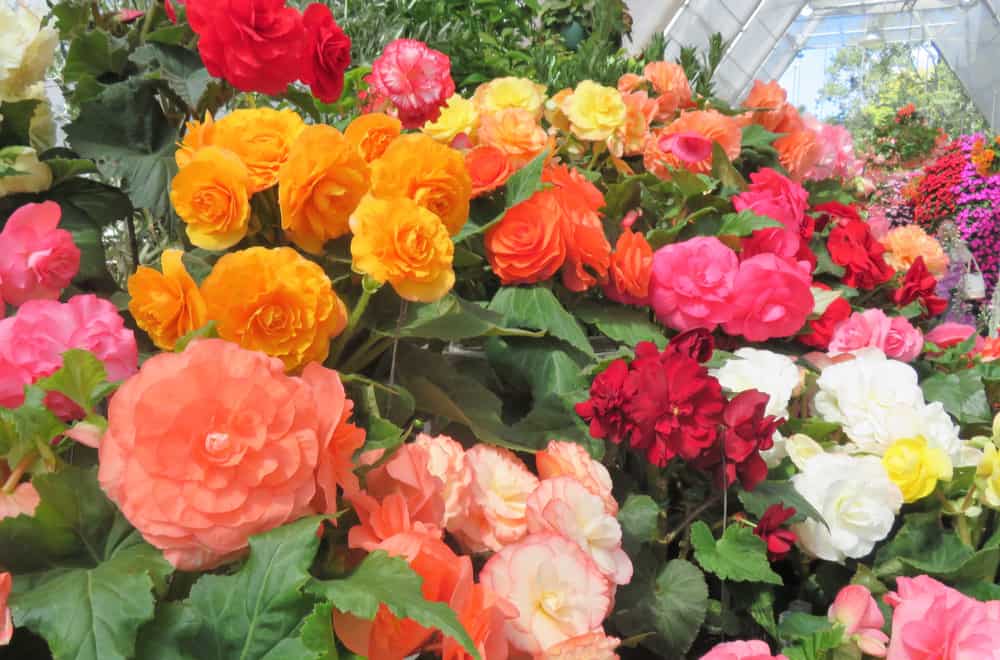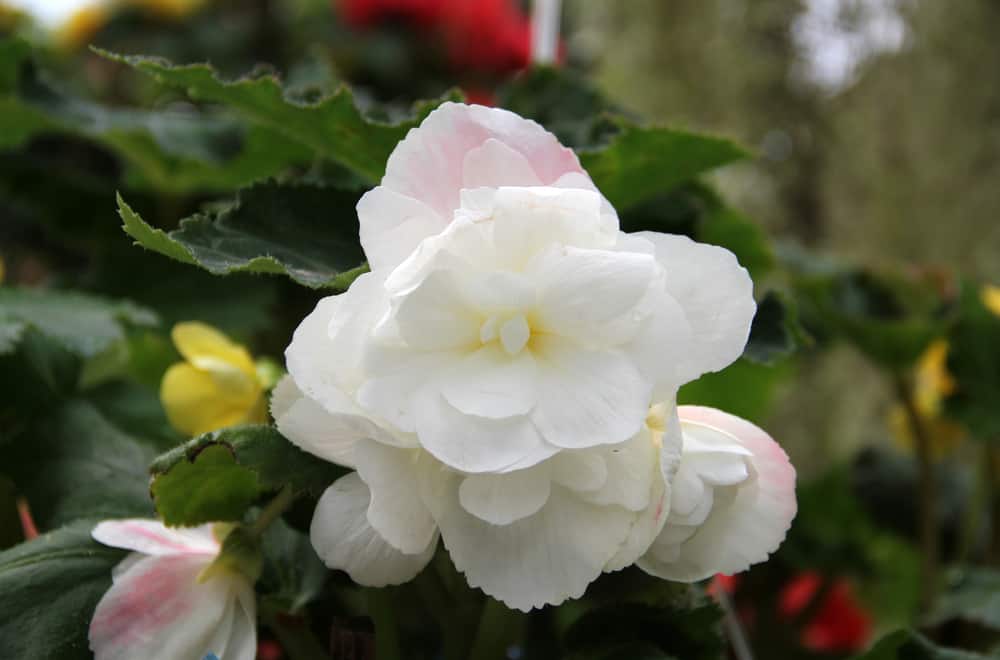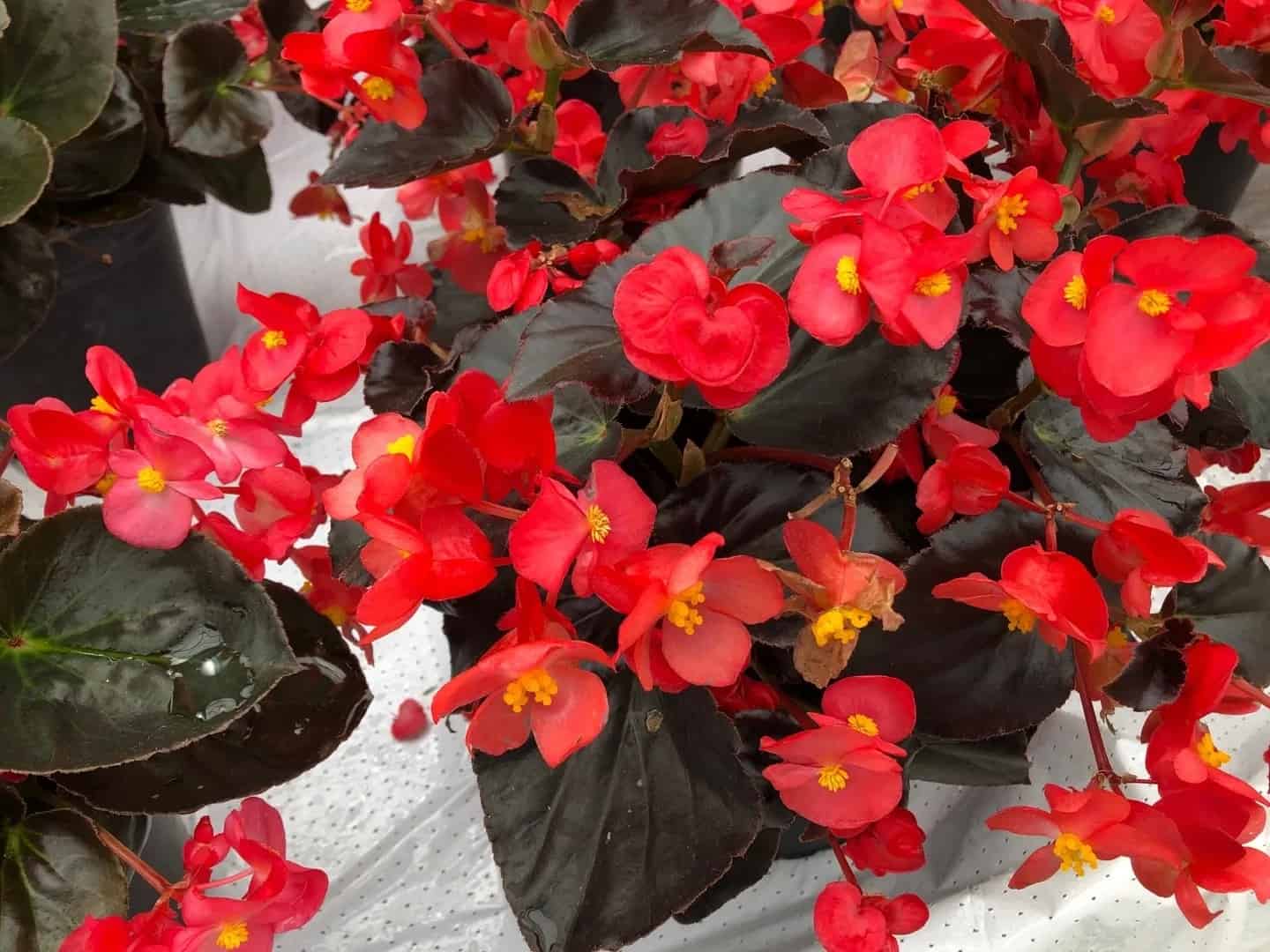The lovely begonia brings bright color to flowerbeds and containers. And with so many different varieties, there’s a plant to suit every garden design.
We’re going to look at the different types of begonia plants and a wide range of varieties. And we’ll share everything you need to know about how to help your begonias thrive.
Ready? Let’s dive in!
Types of Begonias
There are many different types of begonias, each with its own characteristics and preferred conditions.
Tuberous Begonias

Tuberous begonias are those that grow from tubers, rather than having fibrous roots. Most of the modern varieties have been adapted from one species, Begonia x tuberhybrida.
They’re a popular choice because of their bright colors and long lasting blooms. Each plant has both male and female flowers, with the male being the most spectacular.
Tuberous begonias are at home in baskets, containers or flowerbeds. They’ll cope with either full sun or partial shade. And their flowers last right through the summer and into the fall. Give them a weekly dose of high potassium fertiliser, and they’ll reward you with even more blooms.
In dry weather, water them regularly. But avoid getting water on the foliage, as it can leave marks.
Most gardeners go for the easy option and buy new plants each spring. But tuberous begonias can be overwintered with a little care. Just lift the tubers before the first frosts and store them in moist soil until the spring. They’ll need watering occasionally to prevent them drying out.
Hardy Begonias

If you’ve got a shady border that needs brightening up, hardy begonias – Begonia grandis – are an excellent choice. They’ll cope with lower light levels than other varieties. And they’re one of the relatively few plants that combine shade tolerance with brightly colored flowers.
Hardy begonias are also planted from tubers, but you can buy established plants at a reasonable price too. If you’re in an area that has milder winters, you can leave the tubers in the ground all year. Just add some mulch on top of the soil – tree bark works well – to provide a little extra insulation.
But if you don’t want to risk the frosts, the tubers can be removed from the ground in the fall. The time to do it is when the leaves are starting to turn yellow. Lift the plants and store the tubers in moist soil at a temperature of between 35 and 40 degrees Fahrenheit.
When spring comes, start each tuber in a 4-inch pot and keep them indoors at a temperature of about 50 degrees Fahrenheit. They’ll be ready for planting out when the danger of frost has passed.
Wax Begonias

Wax begonias – or Begonia semperflorens, to give them their botanical name – are delicate plants with fibrous roots. They produce lovely blooms in shades of red, white and pink throughout the summer months.
They’re usually treated as annual plants, but in fact they can return year after year in the right conditions.
Like other varieties of begonias, they can handle either full sun or partial shade. And they’ll need watering – avoiding the foliage – if there’s a dry spell over the summer. Feeding them with a fertilizer that’s high in potassium is good too – tomato feed works well.
They can be grown from either seeds or cuttings. But for double flowered varieties, cuttings are the more usual approach.
Cane Begonias

If you’re looking for an indoor plant with spectacular foliage, consider a cane begonia. Keep them pruned, and they’ll create a wonderful focal point on a shelf or windowsill.
Unchecked, though, they can grow up to 10 feet tall. For the tallest plants, you’ll need to give them extra support with stakes.
In some cases, these begonias have tiny flowers, so small that they’re barely noticeable. But the leaves are a different matter entirely, often displaying different colors, spots and streaks.
In others, the showy leaves are combined with clusters of flowers in shades of orange, red, pink or white. For a good display of blooms, the plant will need plenty of indirect light. And houseplant food with lots of nitrogen will promote luscious leaves.
There are a number of different sub-categories. These include “Angel wing begonias” and “Dragon wing begonias”, so called because of the distinctive shape of their leaves. And there are also Superba begonias, cultivated from the species Begonia acontifolia.
Begonia Varieties
1. Begonia “Escargot”, Begonia escargot rex

This lovely cane begonia makes a great houseplant. The leaves are the focus here, with a beautiful spiral pattern in dark olive green and silver. But there are also small pink flowers in the summer months.
The leaves are covered in fine pink hairs, more visible at the edges, and the stalks have red hairs too. They help to trap moisture and provide insulation in cooler temperatures. This is a plant best kept indoors, but it can also provide interest on a shady patio in the summer months.
It likes indirect light and plenty of water when the temperatures are higher. Let the soil dry out slightly, though, before giving it another drink. It’s best watered from below to avoid the moisture leaving spots on the leaves.
In the right conditions, it can grow to a height and spread of 20 inches.
2. Begonia odorata

Begonia odorata is a gorgeous, showy plant that looks great in containers and hanging baskets. It combines masses of flowers with glossy, dark green foliage. The lovely double blooms are found in white, and various shades of red and pink.
The plants should be potted up early in the spring, when the first signs of growth emerge from the tubers. You can then plant them outside when the frosts have passed.
They’ll grow in full sun or partial shade. Keep the soil moist, especially if they’re in direct sunshine. Regular feeding with a balanced liquid fertilizer will give you a great display of blooms from early summer right through to the fall.
3. Begonia (Pendula Group) “White Giant”

Most begonias have a fairly upright form. But the pendula group of tuberous begonias have an elegant trailing habit. That makes them a wonderful choice for cascading from hanging baskets, or tumbling over the edges of containers.
“White Giant” is a great example, with large double flowers which contrast beautifully with glossy, dark green foliage. As with most begonias, it’s happy in full sun or partial shade. But its blooms will look particularly good brightening up a shadier corner.
If it’s kept moist through the summer, it will just keep flowering. And if you bring it under cover in the winter, you may be able to keep it going to the following year.
If you’re looking for a darker color, there’s also a “Red Giant” begonia with rich, scarlet flowers.
4. Begonia “Devil’s Delight”

The striking “Devil’s Delight” showcases some of the unusual shades on offer with begonia foliage.
This is a wax begonia, and the flowers are slightly smaller than those of some other varieties. But that just means the beautiful leaves are more visible. Their gorgeous bronze-red coloring looks great against the red and pink blooms.
They’ll do well in full sun or partial shade, and grow pretty quickly. They’re a great choice for planting along the front of a shadier border, or as patio or container plants. And they’ll typically bloom from May all the way through to October.
5. Begonia “Illumination Apricot”

This stunning begonia features beautiful showy flowers in a warm shade of apricot.
It’s one of the “Illumination Series” of begonias, which feature pendulous stems, oval leaves, and large double blooms. The flowers can be any shade of yellow, white, orange, pink or red. And some varieties have blooms that feature both deep pink and red.
The flowers last throughout the summer and fall.
Plants can grow to a maximum height of anywhere between 4 and 20 inches. They’re perennials, and will achieve that size over up to two years.
6. Begonia “Splendida Alifra”

Splendida Alifra is another begonia with an attractive trailing habit, making it perfect for pots and hanging baskets. It features double blooms in a lovely shade of pink with yellow stamens. The flowers appear in July and keep coming until the first frosts.
It grows fairly quickly, reaching a maximum height and spread of about a foot.
Protect it from the frost, and it can return the following year. If you’ve planted it as a bedding plant, lift the tubers and keep them safe under a thin layer of compost until the warmer weather arrives.
7. Begonia “Mother’s Day”

“Mother’s Day” is an exceptionally long-blooming begonia. Its pretty flowers first appear in May, and it doesn’t stop flowering until the first frosts.
The centre of the flower is almost white, with a pale pink flush that deepens in the outer petals. It’s another variety that trails on arching stems.
Deadhead it regularly for more abundant blooms. It likes soil with plenty of organic matter, and will tolerate partial shade well.
It’s one of the smaller begonias, with a maximum height of about 7 inches, and a spread of about 16 inches. That makes it a good choice as a container plant on a patio or trailing down from a hanging basket.
8. Begonia “Million Kisses” “Honeymoon”

The “Million Kisses” series includes a wide range of different varieties of semi-trailing begonias. This one, “Honeymoon” bears a profusion of small, butter-yellow flowers which contrast with deep green stems and foliage.
Like the rest of the series, it can cope exceptionally well with higher temperatures and drought. And it doesn’t need pruning, trimming, or deadheading, making it very low maintenance.
Its compact habit makes it well suited to a trough, tub, window box or hanging basket.
9. Begonia “Rivulet” “White Elegance”

The “Rivulet” series is the new variant on the “Million Kisses”. It’s an even more robust and bushy begonia. This variety, “White Elegance” is smothered in beautiful white and blush pink flowers from April right through to October.
A fertilizer that’s high in nitrogen will promote the growth of healthy foliage. When buds start to form, switch to a formula that’s high in potassium for abundant blooms.
This begonia can handle pretty much any weather, from heavy rain to drought. And it’s another variety that doesn’t need to be deadheaded to continue blooming freely.
But as with all begonias, it will need to be protected from frosts. Bring container plants under cover, or lift and store the tubers in moist compost until the spring.
10. Begonia “Truffle Cream”

This lovely begonia has an unusual shape flower with a ruffled center surrounded by longer, oval petals. The long, serrated leaves add extra interest.
It’s another good choice for a hanging basket, with the ability to trail in tendrils up to a foot long. Give it plenty of food and keep the soil moist through the summer, and you’ll be rewarded with a globe of lovely pink flowers.
The petals are slightly darker on the underside. It’s another good reason a hanging basket makes the ideal planting location. When the sun shines through the petals, you’ll see the contrasting colors.
The plant will bloom throughout the summer months. But it’s an annual, so it won’t come back the following year.
11. Begonia “Peardrop”

“Peardrop” bears large double flowers with a yellow center that darkens to salmon orange in the outer petals. The blooms are set off by gorgeous deep green leaves with silvery veins.
It has a compact habit that makes it a great container plant. Give it plenty of fertilizer during the growing season, and it will turn into a graceful mound of dark foliage topped with orange flowers.
The first flowers appear in July, and it will continue blooming profusely until October. Its strong performance and good looks saw it win the Royal Horticultural Society’s “People’s Choice” award in 2013.
Bright Color and Low Maintenance
Begonias are a wonderful plant to brighten up a shadier border. They look great in pots and window boxes too. And trailing varieties are a wonderful choice to cascade from hanging baskets.
Their long flowering period and low maintenance requirements make them a boon for any busy gardener. And with so many varieties to choose from, there are colors and styles to suit any planting scheme.

Leave a comment